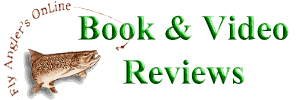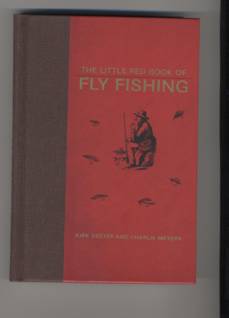- You are here:
- FAOL Home >>
- Articles >>
- Reviews >>
- Book and Video Reviews

Individual taste in books varies as much as the favorite rod or fly. With that in mind, we hope to review books and videos from the ever-growing fly fishing world, and share them with you. Books will be the best of all worlds, new and old. Many of the old books are now available in reprint, and the wisdom contained is timely today. Others can be found in second-hand book stores, or by mail order dealers. As we find videos we feel are outstanding they will be included. Be assured, reviews are based on what we have actually read or viewed, and due to that fact, may not appear weekly.
THE LITTLE RED BOOK OF FLYFISHING

The Little Red Book of FLYFISHING
By Kirk Deeter and Charlie Meyers
Published by Skyhorse Publishing, Inc.
ISBN 10: 1-60239-981-6
200 pages, color photos
5 ½" x 7 1/4"
$16.95
Kirk Deeter and the late Charlie Meyers, two highly respected outdoor journalists and writers for Field & Stream and Denver Post respectively, have cracked open their notebooks - literally - and shared real advice on the sport of fly fishing. Based on their joint experiences - from an interview with the late Lee Wulff to travels with maverick guides in Argentina - it gives them the ability to pass on straight forward, practical and priceless advice in the The Little Red Book of Fly Fishing.
Their mission? Demystify and un-complicate the tips and tricks that make a great trout fisher. No complicated physics lessons here. Instead the book offers a simple, digestible primer on the basic elements of fly fishing: the cast, presentation, reading water and selecting flies.
There are 240 tips in one of the most insightful, plainly spoken and truly entertaining works on fly fishing which will serve beginners and experts alike in helping them reflect on and hone their approaches to fly fishing.
In a world drowning in books on how to be a better fly fisher, this one really has some excellent information (and my late husband Castwell would happily purchase one more fly fishing book in hopes of finding even one tip which would help his fishing, casting or tying.)
Here’s a little sample from the book:
“142. Love That Dirty Water
Don’t be intimidated by dirty water. While it’s easy to think that the fish won’t be feeding because the water of off-color, that simply isn’t the case.
Short of a full-on flood, fish are used to natural fluctuations in river levels, and they feed throughout all of them. They eat more often in certain conditions than others, but they do eat. Dirty water may be a problem for some anglers, but it isn’t to the fish.
I’ll take a day when the water is slightly stained over super-clear water any time, because that colored water tells me there’s a lot of stuff (food) being washed into the river. That murkiness also camouflages me from the fish.
In dirty water conditions, avoid the area where a runoff-fueled creek is pumping thick, muddy in the main current. Instead, look for the transition zone where dirty water meets clear (or at least clearer water), as that’s a great place to cast.
If anything, dirty water narrows down the pockets of opportunity on a river. There may be fewer of these pockets, but when you find them, your probability of finding fish increases dramatically.
Dirty water places a premium on your ability to read the river and the behavior of its currents. Keying on those changes - structure, depth, current seams and so forth - is far more important on dirty-water days than it is when you can spot fish through clear water. On dirty days, you have to use your brain and not just your eyes alone. A lot of people enjoy that. - K.D.”
And one more on using flies:
“148. Use a Spotter Fly
You can use a larger fly so you can spot a rise and take when the fly you are really fishing is too small or dark to see at a distance. One example occurred when I was fishing the basin below the bridge over Silver Creek in Idaho. The trout were eating beetles, so I tied on a size 14 black foam pattern, which came pretty close to imitating the real things.
The problem was that the wind made washboard waves on the surface; past 20 feet and I couldn’t see the fly. To counter that, I tied on a size 10 Turck’s Tarantula, and then trailed the beetle below it.
With any disturbance or splash near the big, visible fly, I’d set the hook, and find the trout had eaten the beetle. As a bonus, about every fifth fish or so ate the Tarantula.
In effect, you use the spotter fly as a strike indicator. Only it’s better than a yarn or foam indicator, because it looks like a bug and is less likely to spook fish; plus, you might catch some fish in the process.
I will always use a fly as a strike indicator over foam or yarn when I can get away with it, and that’s pretty much every situation except classic deep-run high-stick nymphing. - K.D.”
The Little Red Book of Fly Fishing really isn’t a beginner’s book, but then, if you happen to know someone just getting into fly fishing, it would make a dandy gift and the recipient would grow into it. For everyone else, lots of tips to bail you out of situations you know you’re going to have. Truly a good read. I thoroughly enjoyed it.